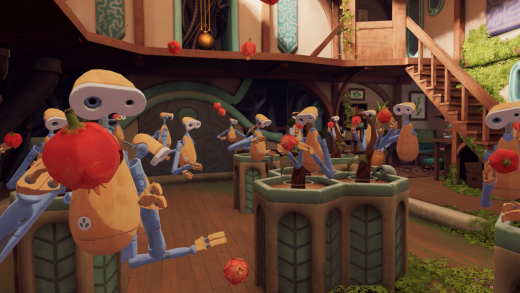:format(webp)/https://www.thestar.com/content/dam/thestar/entertainment/visualarts/2022/06/30/edward-burtynskys-in-the-wake-of-progress-lets-visitors-get-up-close-to-natures-destruction/in_the_wake_of_progress.jpg)
The lush forest in the opening sequence of photographer Edward Burtynsky’s “In the Wake of Progress,” a monumental new film installation at the Canadian Opera Company Theatre, provides visitors with some digital tree-bathing.
Visitors can move around and get up close as a caribou saunters and a bald eagle flies in, surveying the scene across three nine-metre screens. An animator spent six months in post-production adding wildlife and movement to one of Burtynsky’s panoramic still photos and the effects are seamless, down to the rustling ferns.
Despite the peacefulness, there is underlying anxiety. This is Burtynsky, after all, who has dedicated his 40-year career to documenting human impact on the environment. Serenity isn’t the intended takeaway from “In the Wake of Progress.” It’s a call to action and to witness.
Walking through the space, Burtynsky explained that this photo was shot in B.C., capturing one of the only remaining fully biodiverse forest floors in the country. The natural ancient deadfall still supports various ecosystems, where you can “get what nature intended,” he said.
It would be a challenge to shoot a similar scene in Ontario, where only two tiny pockets remain that haven’t been decimated by the logging industry. Only three per cent of these ancient forests still exist in B.C., with 50 per cent of the timber cut every day, making this photo a living document of destruction.
“In a way, this is a call to stop cutting,” Burtynsky said. “This is it.”
What we are left with becomes apparent in the next sequence of the film as the camera soars high above the canopy over what appear to be rows of scrawny toothpicks but are actually replanted second-grade trees that don’t provide the same cover or support the same biodiverse life.
The film continues its journey, surveying the global repercussions of industrial manufacturing through Burtynsky’s large-format photos, often aerially shot using helicopters and drone technology. Meticulous in detail and scope, the images become painterly, abstract in style. But there’s no mistaking what they are, or the feelings of complacency that arise when confronted with photos of factory farming and textile manufacturing.
“There’s nobody that doesn’t contribute to the problem,” Burtynsky said. “Just to be alive, you’re contributing to the problem. Eating, living in a house or going somewhere, it’s all part of it.”
One photo of a tire yard in California, shot with ladders and a truck, is particularly striking for its scale and its waste. Burtynsky pointed out that more than 32 million tires have been dumped here since 1932; the rubber at the bottom flattened like pancakes by the weight of those on top. Three months after he shot that photo, the tires caught fire with flames reaching 2,800 feet high — doubling the height of the CN Tower, for perspective.
“This is a spectacle of what we’ve done,” Burtynsky said. “It really begins to address the scale.”
“In the Wake of Progress” began as an outdoor commission from the Luminato Festival before COVID-19 halted Burtynsky’s work in the field. In his studio, he storyboarded the chronology of his work, mapping out more than 800 images to tell a visual story. “Everything is interconnected,” he said.
He added a temporary score using industrial-sounding music by artists like Brian Eno, which was abandoned once Toronto sound designer Phil Strong came on board to create the final soundtrack. The music adds emotional power, in particular wordless vocals by iskwē, a Cree-Métis musician from Treaty One Territory, drawing the humanity out of the images.
“I was really interested in iskwē’s vocals because they’re haunting,” said Burtynsky. “At the very beginning, I kind of saw her opening voice as the land acknowledgment.”
The installation premiered on June 11 at Yonge-Dundas Square, the soundtrack competing with the cacophony of street preachers, drummers and traffic. Burtynsky felt the experience went better than he expected but notes that the low-resolution screens couldn’t refresh quickly enough for viewers to take in the images as he intended. The theatre, on the other hand, provides an opportunity for full immersion.
“Technically this is a far superior visual and audio experience here,” he said.
Technology has always been a cornerstone of Burtynsky’s career, from his early days pushing the capabilities of large-scale cameras to embracing drones to capture some of his iconic aerial views. After the film ends, visitors are free to catch their breath looking up close at photos before heading into a “Change Station,” highlighting the work of various environmental organizations.
A final space is dedicated to the legacy of the internal combustion engine. Here, there are two augmented reality experiences accessible through iPads and a custom app created by Burtynsky’s lab that provide an even closer look at the repercussions of industry. The photographic detail is incredible, each angle shot methodically, and rendered together for a 3D experience.
Although “In the Wake of Progress” in its entirety is a heady experience, there are glimmers of hope, if only as a chance to contemplate our connections to humanity on a more global scale. Initially, Burtynsky thought about adding text to the film but ultimately decided against it. “With pictures you don’t need words. And because there are zero words, it can then go all around the world,” he said. “It’s speaking universally and it doesn’t need a translation anywhere.”
JOIN THE CONVERSATION


